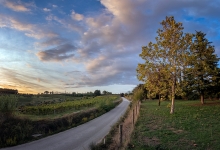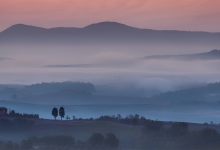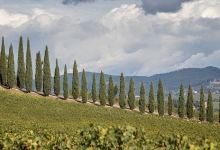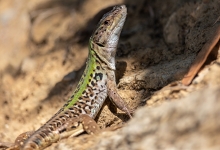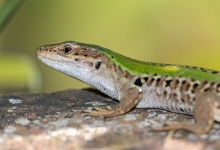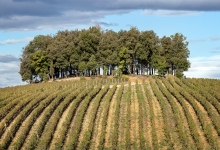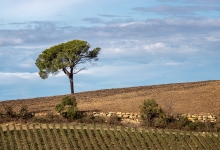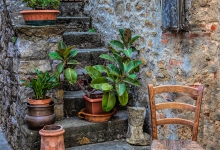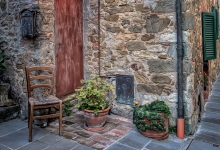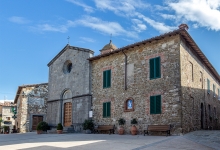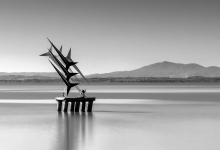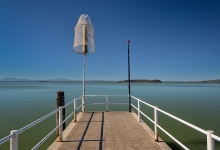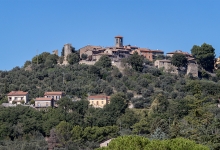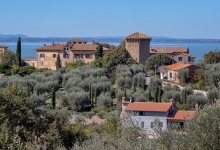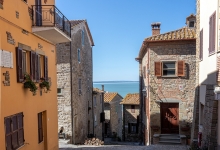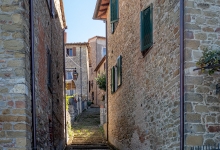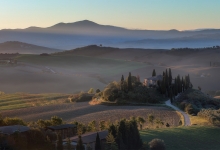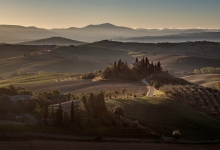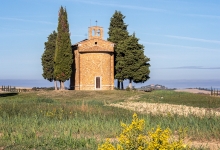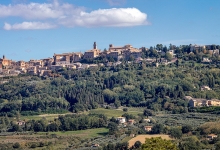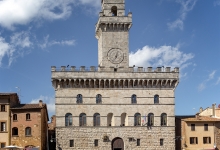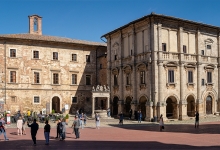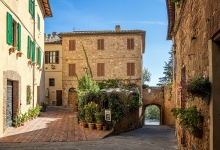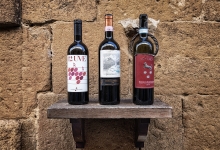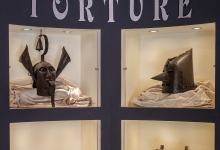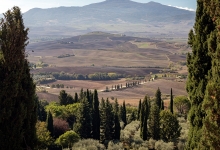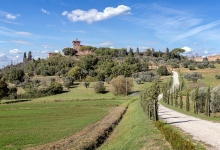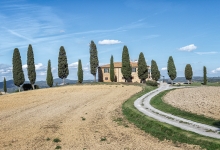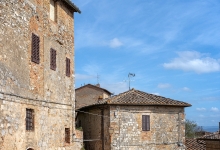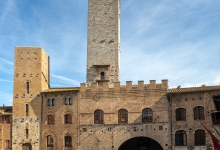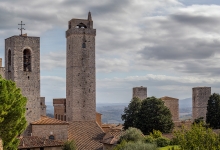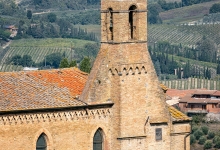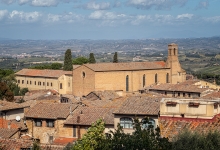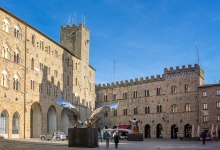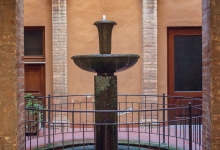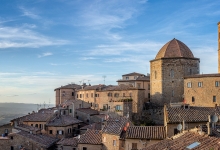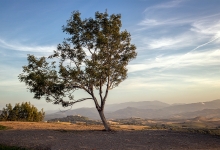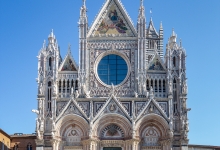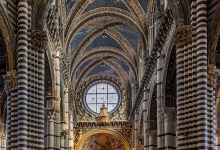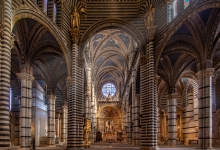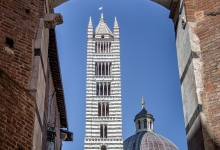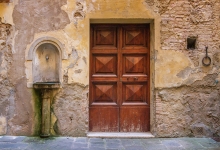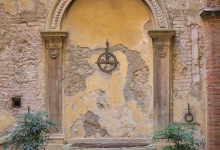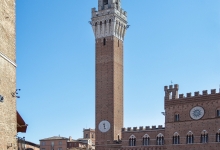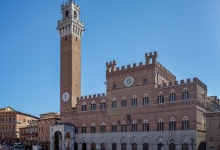In October 2019 we spent a week’s holiday in Tuscany, staying at Borgo Argiano – a hotel and vineyard just outside the village of Pianella at the southern edge of the Chianti wine region. We flew to Pisa Airport, where we hired a car for the drive to Pianella. The following day was the day of the Eroica bike ride, which involves up to 7000 cyclists all using vintage bikes. The route of the bike ride passed right outside our hotel, so knowing that the roads would be clogged up with cyclists we decided to stay local and did a short walk from our hotel. On subsequent days we traveled further afield, visiting some of the historic towns in Tuscany, so our itinerary for the week was as follows:-
Day 1 – Local Walk near Pianella
Day 2 – Drive to Castellina and Rada in Chianti
Day 3 – Lake Trasimeno
Day 4 – Val D’Orcia and Montepulciano
Day 5 – San Gimignano and Volterra
Day 6 – Siena
Borgo Argiano
A few pictures from the evening that we arrived at our hotel.
Day 1 – Pianella
Just before sunrise we walked to the top of the Borgo Argiano vineyards, which gave views across the Chianti countryside. We were fortunate on this morning as there was a bit of mist about, which gave a bit of atmosphere to the views. Later in the day, we took a short walk, visiting the small village of Vitignano before descending to Pianella, then walking back to our hotel. On the return we passed a small chapel or Tenuta Capellina, which has been adopted as the name of the wines produced at Borgo Argiano. We also passed a bank of earth at the roadside where there were numerous lizards. I thought I was doing well to photograph one, but when we returned to our rooms, there was a lizard on the patio, which was quite happy to pose for some close-up shots.
Day 2 – Castellini and Rada In Chianti
Today we took a drive around the Chianti growing region of Tuscany, visiting a few of the towns in the area, but with no specific objective in mind. Our route took us north from our hotel, initially to the small scenic village of Vagliagli. After that we drove through Castellina in Chianti and Rada in Chianti, but as these were larger towns we did not stop for photographs. Later on in the evening as the sky was clear, I went out for some photographs of the night sky, however as there was a full moon, the Milky Way was not very visible.
Day 3 – Lake Trasimeno
Today we drove to Lake Trasimeno, which is the largest lake in Italy outside of the Alpine area. The lake is wide and shallow being only about 5m deep on average, and is unusual in having no river outlet, so the water level can vary significantly depending on rainfall and evaporation rates. There are several resort towns and castles around the lake, and we visited Passignano sul Trasimeno on the north side of the lake before driving around to Monte del Lago on the east side.
Day 4 – Val D’Orcia and Montepulciano
This morning we decided on an early start to visit the Val D’Orcia, which is about 1 hours drive south of where we were staying. Just outside the town of San Quirico D’Orcia there is a well known view of the Podere Belvedere which often provides atmospheric misty morning views so we set of very early to arrive before sunrise. Unfortunately there was no mist that morning, but we still enjoyed the sunrise. Nearby is the small chapel Cappella Madonna di Vitaleto, and while this is in view from the main road, it can only be reached by turning south off the road then requires a short walk of about 1km. Later in the day we travelled on to Montepulciano, mainly because we knew it as a wine producing town, and we quite liked the name! The town is set on a limestone ridge and can be photographed from the main road (the SP146). The town is a centre of food and wine production and has plenty of narrow medieval streets so typical of towns in Tuscany. The Town Hall was designed by Michelozzo in the 15th century and is very similar to the Palazzo della Signoria in Florence.
On the return journey from Montepulciano, we took a few more photographs of some of the villas in view from the main road through Val D’Orcia – Botegga Verde and the Farmhoues I Cipressini, before the drive back to Borgo Argiano.
Day 5 – San Gimignano and Volterra
Today we visited the Tuscan towns of San Gimignano and Volterra. Both are typical hilltop Tuscan towns with a Medieval town centre, but San Gimignano is the more famous of the two due to the numerous towers built by competing families during the Middle Ages. The practice of building defensive towers was fairly common in Tuscany, however most of these have either fallen down or been replaced by later building works. San Gimignano itself once boasted 72 towers, of which 14 survive today. Both San Gimignano and Volterra are walled towns with narrow cobbled streets, so vehicle access by tourists is not permitted and cars have to be parked outside the towns.
San Gimignano is located about 40km North-West of Siena and 50km South-West of Florence, whilst Volterra is about 30km further west towards the coast.
Day 6 – Siena
On our last day in Tuscany we visited the city of Siena. Our first stop was to visit Siena Cathedral with its very impressive western facade. This is a problem to photograph, both to fit it in the frame and have it reasonably clear of tourists. Photography inside the cathedral is also difficult as no tripods or flash are allowed. Nevertheless, the cathedral is an impressive piece of architecture as it was intended to show off the power and wealth of 13th century Siena, and much of the interior is decorated with white and dark green marble. By the time the cathedral was completed in about 1370 however, Siena had been devastated by the Black Death, which wiped out half of the population. Plans to enlarge the cathedral were shelved, and the city never fully regained its earlier prosperity. One of the impressive features of the cathedral interior is the mosaic flooring, however this is only uncovered for a few weeks a year to protect it from deterioration, and it was unfortunately covered during our visit. There are two stained glass rose windows at either end of the cathedral, but the older window at the choir end was out of reach as this part of the cathedral was roped off. The other window showing the Last Supper makes a fine photographic subject however.
The other main site in Siena is the Piazza del Campo, the shell like central square which is the location for the famous Palio di Siena – the horse race around the square when different areas of the city compete against each other. The Piazza is backed by the Palazzo Pubblico, which was built in the early 14th century before the Black Death struck. The tower (the Tore del Mangia) was designed to be the same height as the cathedral but most importantly, was taller than the similar tower in Siena’s chief rival Florence. Several cafes and restaurants line the square, and these are a good place to pass the time, watching the crowds of tourists who visit Siena.



